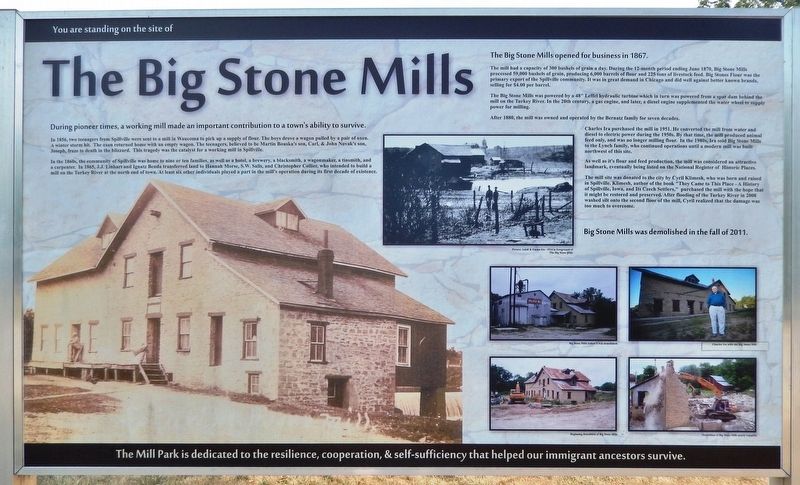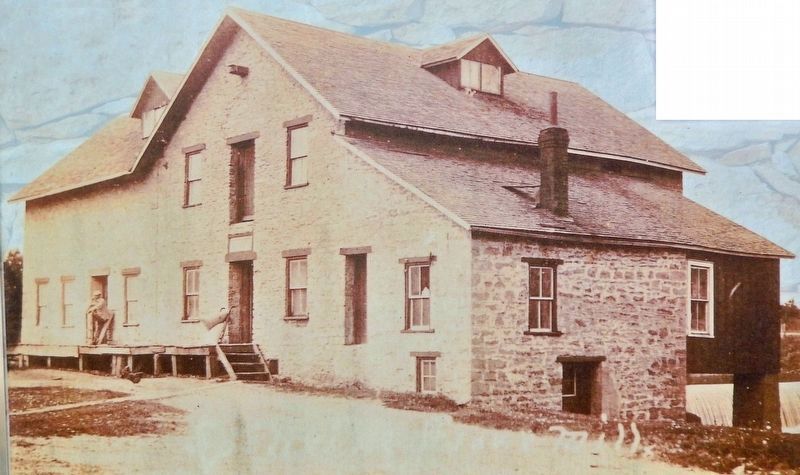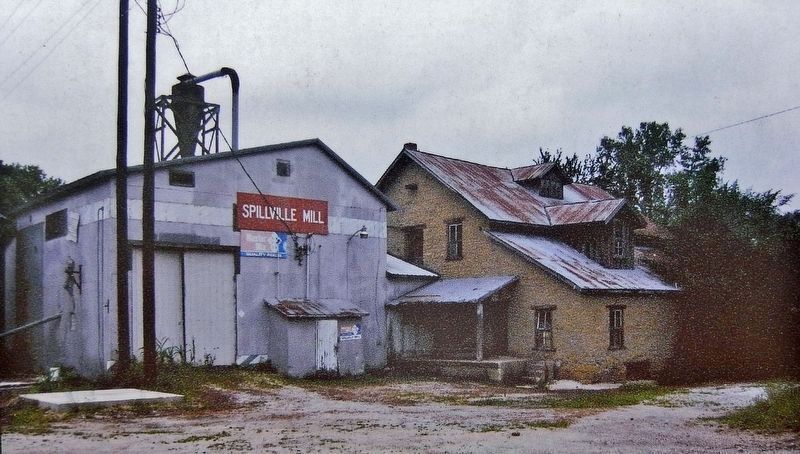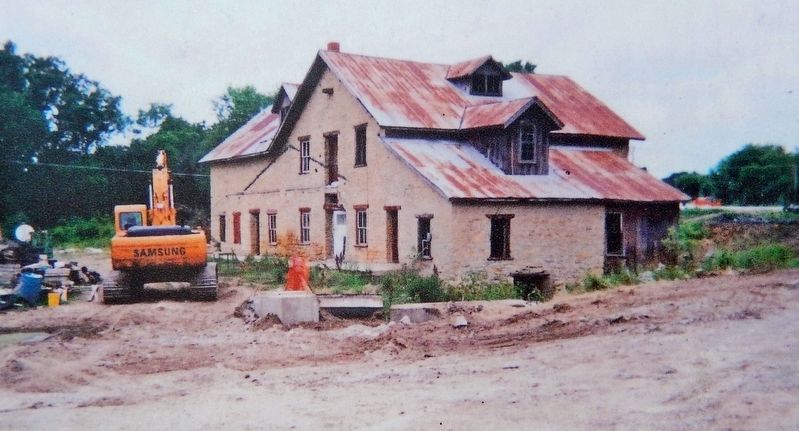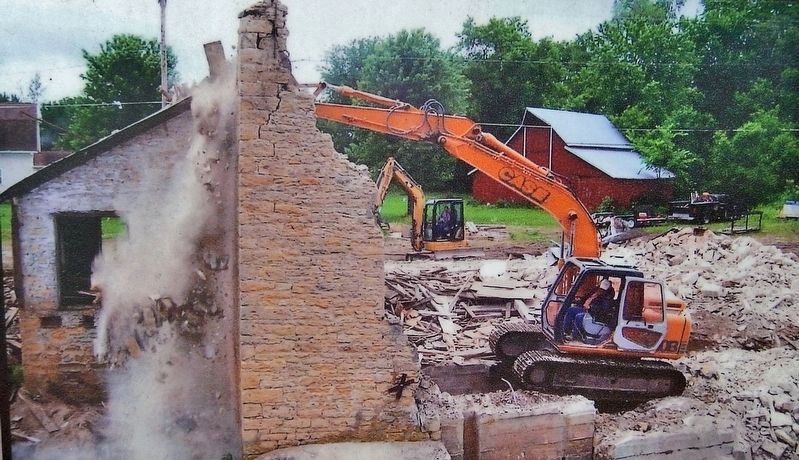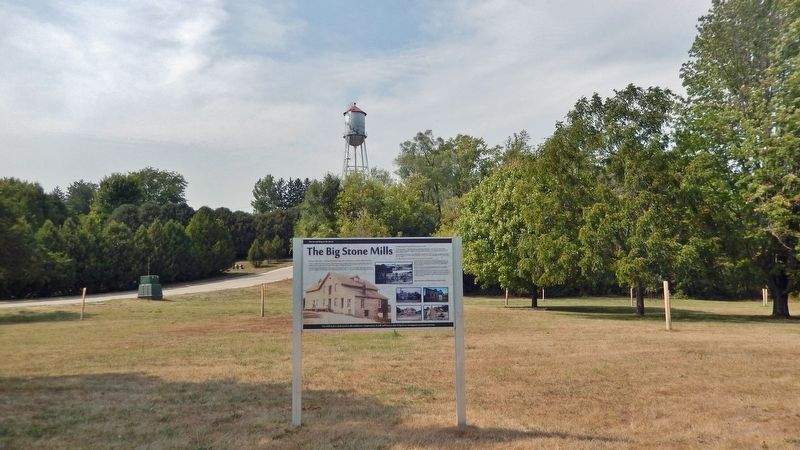The Big Stone Mills
During pioneer times, a working mill made an important contribution to a town's ability to survive.
In 1856, two teenagers from Spillville were sent to a mill in Waucoma to pick up a supply of flour. The boys drove a wagon pulled by a pair of oxen. A winter storm hit. The oxen returned home with an empty wagon. The teenagers, believed to be Martin Bouska's son, Carl, & John Novak's son, Joseph, froze to death in the blizzard. This tragedy was the catalyst for a working mill in Spillville.
In the 1860s, the community of Spillville was home to nine or ten families, as well as a hotel, a brewery, a blacksmith, a wagonmaker, a tinsmith, and a carpenter. In 1865, J.J. Linhart and Ignatz Benda transferred land to Hannah Morse, S.W. Salls, and Christopher Collier, who intended to build a mill on the Turkey River at the north end of town. At least six other individuals played a part in the mill's operation during its first decade of existence.
The Big Stone Mills opened for business in 1867.
The mill had a capacity of 300 bushels of grain a day. During the 12-month period ending June 1870, Big Stone Mills processed 59,000 bushels of grain, producing 6,000 barrels of flour and 225 tons of livestock feed. Big Stones Flour was the primary export of the Spillville community. It was in great demand in Chicago and did well against better known brands, selling for $4.00 per barrel.
The Big Stone Mills was powered by a 48" Leffel hydraulic turbine which in turn was powered from a spar dam behind the mill on the Turkey River. In the 20th century, a gas engine, and later, a diesel engine supplemented the water wheel to supply power for milling.
After 1880, the mill was owned and operated by the Bernatz family for seven decades.
Charles Ira purchased the mill in 1951. He converted the mill from water and diesel to electric power during the 1950s. By that time, the mill produced animal feed only, and was no longer milling flour. In the 1980s, Ira sold Big Stone Mills to the Lynch family, who continued operations until a modern mill was built northwest of this site.
As well as its flour and feed production, the mill was considered an attractive landmark, eventually being listed on the National Register of Historic Places.
The mill site was donated to the city by Cyril Klimesh, who was born and raised in Spillville. Klimesh, author of the book "They Came to This Place - A History of Spillville, Iowa, and Its Czech Settlers," purchased the mill with the hope that it might be restored and preserved. After flooding of the Turkey River in 2008 washed silt onto the second floor of the mill, Cyril realized that the damage was too much to overcome.
Big Stone Mills was demolished in the fall of 2011.
[other photo captions]
• Adolf & Emma Ira — 1914 in foreground of The Big Stone Mills.
• Charles Ira with the Big Stone Mill
Topics and series. This historical marker is listed in these topic lists: Agriculture • Disasters • Industry & Commerce • Settlements & Settlers. In addition, it is included in the National Register of Historic Places series list. A significant historical year for this entry is 1867.
Location. 43° 12.431′ N, 91° 57.053′ W. Marker is in Spillville, Iowa, in Winneshiek County. Marker is on North Main Street just north of Mill Street, on the left when traveling north. Touch for map. Marker is in this post office area: Spillville IA 52168, United States of America. Touch for directions.
Other nearby markers. At least 8 other markers are within 5 miles of this marker, measured as the crow flies. Clarence C. Haug Major General (about 800 feet away, measured in a direct line); Wenzil Taylor Building (approx. 0.4 miles away); Antonín Dvořák (approx. half a mile away); Lincoln Lutheran Congregation (approx. 4.2 miles away); Guard House (approx. 4.3 miles away); Sutler's Store and Post Commissary (approx. 4.3 miles away); Fort Atkinson (approx. 4.3 miles away); Constructing Fort Atkinson (approx. 4.3 miles away). Touch for a list and map of all markers in Spillville.
Regarding The Big Stone Mills. Formerly listed on the National Register of Historic Places, #09000516.
From the National Register Nomination:
When Big Stone Mills came into operation in 1866 it provided a much-needed service to the fledgling community's farmers. All of the county's land had been taken over by settlers and was slowly being placed under cultivation with wheat being the primary crop. In 1870 Winneshiek County was rated as the 4th leading wheat raising county in the nation.During those early years transportation was by horse or ox drawn wagon. With roads no more than ruts in the landscape a local mill was the sole convenient grain market for Spillville area farmers. It was also the prime source of flour for the housewives. Sans a local mill, the residents had to haul their grain to a neighboring mill to sell it or have it processed into meal or flour. By ox team the trip took three days at best.
Unlike the conventional paddle or bucket wheel, which usually was designed and fabricated locally, the Leffel American Double Turbine Water Wheel installed in the mill was the product of a foundry in Springfield, Ohio. Only recently patented by its inventor, James Leffel, the new turbine was the most efficient to be found on the market. Durable and dependable, the Leffel turbine needed little maintenance
and could function when the water level was low. Installed in the floor of the flume built against the north foundation of the mill, the completely submerged turbine was capable of supplying thirty horsepower of energy.With its advanced Leffel Turbine, two mill stones, substantial dam and other equipment the Big Stone Mills was ahead of its time in the 1860s. Big Stone Mills provided a market for grain and milling services to the area farmers for well over a century.
Also see . . . Spillville Mill / Big Stone Mills. Excerpt:
(includes photos of the mill) The little community of Spielville (Spillville) in 1860 boasted only about nine or ten families. Others soon moved in around this core nucleus, mostly Czech immigrants, Swiss, and German settlers. The Big Stone Mills began in 1865 through the efforts of Morse, Salls, and Collier, three businessmen from Decorah. The mill was later owned by John Barnatz, who also owned and operated the Barnatz-Painter Mill in Decorah at one time.(Submitted on January 11, 2024, by Cosmos Mariner of Cape Canaveral, Florida.)
Credits. This page was last revised on January 11, 2024. It was originally submitted on January 7, 2024, by Cosmos Mariner of Cape Canaveral, Florida. This page has been viewed 62 times since then. Photos: 1, 2, 3, 4, 5, 6. submitted on January 11, 2024, by Cosmos Mariner of Cape Canaveral, Florida.
